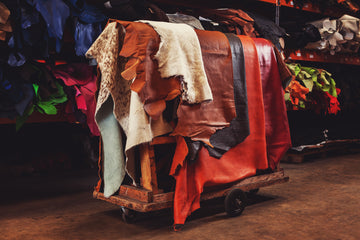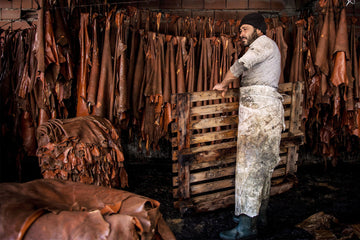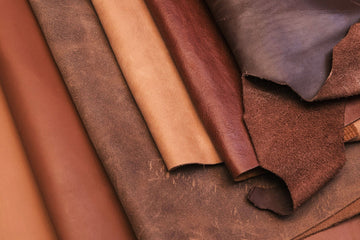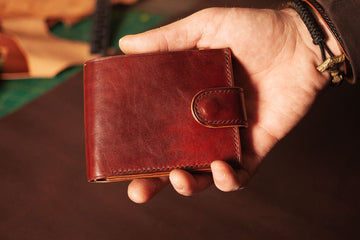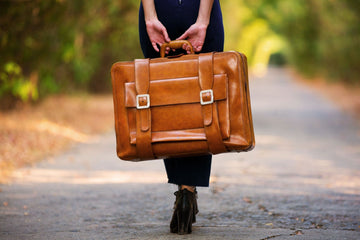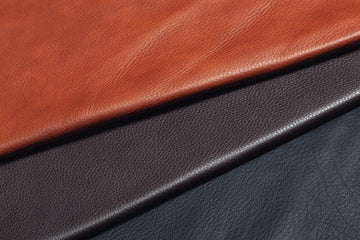Genuine leather is a versatile material made from animal hides through tanning. This process involves cleaning, treating, and finishing the hides to make them durable and flexible. In this guide, we’ll dive into what leather is, how it is produced, its properties, and its detailed production steps.
Key Takeaways
- Leather is primarily a by-product of the meat industry, and its quality is influenced by factors such as the animal’s upbringing and treatment during its life.
- The leather production process consists of raw material preparation, tanning, and post-tanning processes, each crucial for transforming raw hides into durable leather.
- The leather industry faces significant environmental challenges, but sustainable practices such as chrome-free tanning and lab-grown leather are emerging to mitigate its impacts. The leather produced using traditional tannin methods is more sustainable than harmful chemicals like chromium III sulfate, highlighting the importance of ethical considerations in leather manufacturing.
What is Leather, and How Is It Produced
The process of leather making primarily utilises a secondary product from the meat industry, with tanned animal hides serving as the foundation. These skins can come from various animals, including cows, pigs, goats, sheep or even more unusual sources, such as crocodiles and snakes. Factors like how the animal was raised, its diet, and environmental exposure to elements such as branding or insect bites play pivotal roles in determining leather quality. This raw material is then processed through the leather manufacturing stages to become strong and pliable for use across numerous applications.
The leather made through these processes involves careful and technical methods to transform animal hides into high-quality products like bags and clothing. Additionally, alternatives to traditional leather are emerging, such as cultured leather made from lab-grown materials and biodegradable options like mushroom-based leather.
China leads the global production of this transformed hide into robust materials suitable for crafting various items. Italy is renowned for exporting some of the highest-value luxurious leather products worldwide. Brazil, Russia, and India also significantly contribute to shaping the dynamic landscape within the sector. Depending on the techniques employed in each country, a spectrum of grades is available, ranging from deluxe complete grain selections to economical bonded alternatives.
Introduction to Leather
Understanding leather's characteristics and manufacturing process is crucial for valuing its diverse applications and acknowledging its potential environmental impact. This guide intends to offer an exhaustive examination of leather, detailing its historical importance and principal attributes and the complex methods used to produce it, including the meticulous leather dyeing process.
By gaining a more comprehensive insight into leather, consumers can make better-informed decisions regarding purchasing leather goods while considering their ecological footprint.
Understanding Leather
Leather, a material steeped in history and possessing distinctive characteristics, has been an integral part of human society for centuries. This exploration delves into the essence of leather, its profound historical importance, and the principal attributes that render it an invaluable resource.
Recognising these elements allows us to understand the evolution of leather from its early use in antiquity to its contemporary uses.
What Is Leather?
Leather is a resilient and pliable substance produced by tanning animal hides. The skins primarily come from cattle, including goats, pigs, sheep, and other animals. During the leather-making process, these hides are treated to halt decomposition while maintaining their inherent texture and distinctive marks.
Such treatment augments leather's visual appeal and simultaneously amplifies its functional qualities. As a result, it has become appropriate for a wide array of purposes in the fashion and industrial sectors.
Leather's versatility and durability have been a staple material across various industries for centuries. Its unique properties, such as breathability, strength, and adaptability, allow it to be used in diverse applications, ranging from luxury fashion items to industrial machinery components. The inherent beauty and texture of leather make it a favoured choice for designers and artisans, who appreciate its ability to enhance their creations' aesthetic and functional aspects.
In the fashion industry, leather is synonymous with elegance and sophistication and is often used to create high-end garments, accessories, and footwear. Its ability to mould to the body and develop a patina over time adds to its allure, making leather products highly sought after by consumers. Beyond fashion, leather is essential in the automotive and furniture industries, where its durability and comfort are highly valued for upholstery and interior applications.
Moreover, leather's natural resistance to wear and tear and its capacity to be treated and finished in various ways ensure its continued relevance in modern manufacturing. From vegetable-tanned leather, which offers an eco-friendly alternative, to chrome-tanned leather, known for its softness and uniformity, the different tanning methods provide a wide range of options to meet specific needs.
Historical Significance of Leather
Leather's importance dates back to ancient times, when it was pivotal in providing early humans with garments, implements, and dwellings. By processing animal hides through different treatments, they could fashion a substance with the ideal combination of strength and suppleness. Artefacts made from leather that have been unearthed are believed to be as old as 5000 BC, attesting to its enduring significance throughout human history.
Over many generations, the process of producing leather has been significantly refined regarding its use cases and manufacturing techniques. The onset of the Industrial Revolution marked an incredibly transformative period for leather production, enhancing productivity and ecological footprint.
Beyond its practical applications, leather has held symbolic and cultural significance in various civilisations. In ancient Egypt, leather was used for practical items like sandals, shields, and ceremonial purposes, reflecting its status as a valuable material. Similarly, in medieval Europe, leather was a key component in creating armour and weaponry, highlighting its role in protection and warfare.
Over the centuries, the evolution of leather production techniques has also mirrored broader technological advancements. Introducing tanning methods such as vegetable and chrome tanning revolutionised the industry, allowing for more efficient and diverse production processes. These innovations have created various leather types with unique properties suited to different applications.
Today, the leather industry continues to evolve, integrating modern technologies and sustainable practices to meet the demands of a changing world. The development of lab-grown leather and the use of recycled materials are examples of how the industry is adapting to address environmental concerns while maintaining the quality and versatility that have defined leather for millennia.
Key Properties of Leather
Valued for its remarkable strength, pliability, and innate beauty, leather is a favoured substance in creating premium goods. Its resilience against damage and inherent tactile allure contribute to its widespread use. Due to its adaptability, leather can be shaped into diverse configurations that meet various stylistic requirements.
Combining these attributes—its durability and natural porosity, which lead to breathability and comfort—secures leather’s role as a highly sought-after and multifunctional material in contemporary uses.
Beyond its fundamental properties, the leather exhibits exceptional versatility, allowing it to be tailored for specific needs. For instance, its ability to absorb and retain dyes ensures that leather products can be crafted in a broad spectrum of colours, enhancing their aesthetic appeal. The natural oils in leather also contribute to its water-resistant qualities, making it suitable for outdoor applications and ensuring its longevity even in harsh conditions.
Additionally, leather's unique pore structure facilitates air circulation, which is particularly advantageous in applications such as footwear and upholstery, where comfort is paramount. This breathability prevents excess moisture buildup, maintaining a comfortable environment for the user. Furthermore, leather's ability to develop a rich patina over time adds to its allure. It tells a story of age and use, making each piece distinct and personal.
Leather's adaptability extends to its various finishes and treatments, which can enhance its natural properties or imbue it with new characteristics. Techniques such as embossing, perforation, and coating with protective layers allow for creating leather products that meet specific functional and aesthetic requirements. These processes ensure that leather remains relevant and desirable in an ever-evolving market where consumer preferences and technological advancements continually shape its applications.
The Leather Production Process
Transforming raw animal hides into finished leather encompasses multiple complex steps, with the entire process of leather production divided mainly into three critical stages: preparing the raw material, executing the tanning process, and carrying out post-tanning treatments. These successive phases are essential for converting unprocessed hides into premium-quality leather that can be used for diverse purposes.
These stages collectively unveil the intricate nature of crafting leather through manufacturing processes.
Raw Material Preparation
Leather production begins with the crucial step of preparing raw animal hides. These hides are treated with either salt directly or immersion in saline to halt decomposition and stabilise them.
Subsequently, these preserved hides undergo rehydration through soaking, which cleanses them. A desalting stage follows to eliminate residual salt content, thereby conditioning the hides for optimal results during the ensuing tanning process.
Leather Tanning Process
The tanning process is at the core of leather production, a key phase that converts raw animal hides into strong and pliable leather. The practice encompasses various tanning methods, including vegetable and chrome tanning, among the most prevalent techniques. Vegetable-tanned leather is produced using organic materials like a mimosa, chestnut tree extracts, and bark to solidify the collagen fibres within the hide—yielding a sturdy material with an inherent hue from its natural sources. In contrast, one obtains a supple yet evenly finished material through leather tanning employing chrome salts.
No matter what technique is adopted for producing it, every method involves immersing hides in a solution designed for tanning. This treatment chemically bonds to their collagen fibres, enhancing resilience against deterioration and flexibility suited for everyday functionality. This essential stage plays an instrumental role in shaping qualities such as texture, colouration, and overall endurance of the final product – creating distinct types of usable leather fit for diverse applications.
Leather Post-Tanning Processes
After the leather has been tanned, it undergoes additional post-tanning steps to refine its quality. These processes include drying techniques such as air and vacuum drying to eliminate any remaining moisture within the leather. Vacuum drying, in particular, contributes to a refined texture by withdrawing air from around the material, which results in minor shrinkage. Once dried, the leather is stained with dyes for colouration purposes before undergoing another washing and drying cycle to guarantee consistency.
In the final stage, surface treatments enhance the leather's durability and visual appeal. Techniques like embossing or adding protective layers contribute significantly to this end. At the same time, oils and greases may be introduced into the leather's composition, rendering it more pliant and resistant to water infiltration. Such finishing efforts improve its aesthetic and serve as safeguards for longevity, ensuring that the leather can effectively withstand varied uses once complete.
Different Types of Leather
Various classifications of leather exist, distinguished by quality and the finishing processes they undergo. Awareness of these distinctions is critical when choosing appropriate leather for a particular purpose. Key categories encompass full-grain, top-grain, split, and bonded leather. All possess distinct attributes and are suited for different applications.
What Is Full Grain Leather
Full-grain leather, regarded as the pinnacle of quality in leather goods, is crafted from the uppermost layer of animal hide. This preserves its authentic texture and inherent flaws, rendering it strong and unique to each piece. Its resilience leads to an elegant patina that enhances over years of use, which is why luxury items like belts, footwear, and outerwear often feature full-grain leather.
In addition to its aesthetic and durability advantages, full-grain leather is also known for its breathability, which enhances comfort in items like shoes and jackets. This type of leather allows natural air circulation, preventing moisture buildup and ensuring that the material remains comfortable against the skin even during extended wear. Furthermore, full-grain leather is easier to care for than other leather types. With proper maintenance, such as regular conditioning with natural oils and avoiding exposure to excessive moisture, full-grain leather can last for decades, often becoming more beautiful.
Full-grain leather is also an environmentally conscious choice for consumers who value sustainability. It uses the entire hide without sanding or buffing away imperfections, reducing waste in the leather production process. This aligns with the growing consumer demand for eco-friendly products, making full-grain leather a symbol of luxury and a responsible choice for environmentally aware individuals.
What Is Top Grain Leather
Derived from the hide’s outer layer, top-grain leather is the second-most superior leather quality. It is distinguished from full-grain leather by its refinement process. It undergoes sanding and corrections to eliminate blemishes, culminating in a uniform and smooth surface.
Consequently, due to its refined appearance, top-grain leather is an ideal choice for fashion items such as jackets and coats and accessories like gloves and hats, where a sophisticated look is favoured.
Top-grain leather is also celebrated for its versatility and ease of maintenance, making it a popular choice for various leather goods. Its smoother finish allows for easier cleaning and less susceptibility to stains and damage, which is particularly advantageous for items that experience frequent use. This characteristic makes top-grain leather suitable for fashion furniture and car upholstery, where aesthetics and practicality are essential.
Additionally, top-grain leather can be dyed in various colours, providing manufacturers and designers with various design possibilities. This adaptability ensures that top-grain leather can cater to diverse consumer preferences, from classic tones to vibrant hues, enhancing its appeal across different markets.
What Is Split Leather and Bonded Leather
Produced from the lower strata of a hide, split leather is derived once the uppermost grain layer has been separated. It tends to be employed in creating less expensive items such as gloves and furniture upholstery, given its inferior durability when juxtaposed with full-grain or top-grain leather. To enhance aesthetics, split leathers may receive a coating of vinyl or polyurethane, resulting in patent or bi-cast leather that boasts a glossy surface yet does not retain the authentic texture associated with premium quality leather.
In contrast, bonded leather comprises pulverised remnants of leather fibres fused using latex or polyurethane adhesives. While this type represents an economical alternative to other leather materials available on the market, it lacks robustness and is often selected for products where endurance isn’t paramount. Despite these shortcomings, bonded varieties provide an opportunity to repurpose leftover scraps from other industry processes, paving the way for potentially more ecological approaches to manufacturing goods involving lesser-used forms of grain leathers.
Leather Grades and Types
Leather is classified into various grades and types based on its quality, durability, and appearance. Understanding these classifications can help consumers make informed decisions about purchasing leather goods.
Leather's adaptability is evident through its extensive use in numerous sectors. Its distinctive characteristics make it a favoured choice for various items, from fashion to home décor.
Leather for Apparel
Leather enjoys widespread acclaim in fashion, where it is frequently selected for crafting jackets, coats, boots, and leather shoes. Its robustness and comfort render it ideal for demanding professions like those associated with cowboys and bikers.
The use of leather extends to the manufacture of sports gear as well. Due to its resilient nature and multifaceted applications, it’s a preferred material for items such as baseball mitts and balls employed in games like cricket and football.
Leather for Accessories
Accessories crafted from leather are celebrated for their practicality and the elegance they bring, often seen in purses, handbags, suitcases, luggage sets, briefcases, belts, and wallets. Thanks to its robustness and fashionable allure, leather is a popular choice for products used regularly or during travel.
Not only do these leather goods fulfil functional needs, but they also enhance the aesthetic of one’s attire by infusing an aspect of refinement.
🔗 Shop leather for accessories
Leather for Homewares and Industrial Applications
Leather is frequently utilised in residential and industrial settings, often serving as the preferred material for upholstering various items, including sofas, chairs, and car seats. This preference is due to its exceptional durability and resistance to frequent use.
Leather enhances home aesthetics with a luxurious appeal when employed in decorative pieces like throw pillows, rugs, and wall decorations. Its robust nature contributes both style and longevity to these decor elements.
Environmental Impact of Leather Production
Leather, as a sought-after commodity, carries with it substantial ecological costs. Manufacturing leather plays a role in exacerbating global warming through greenhouse gas emissions, contributing to the loss of forests and contaminating water bodies. The energy demands for tanning leather are considerable and frequently depend on fossil fuels, increasing the carbon footprint associated with this industry. Inadequately handled waste from leather production also poses risks of profound environmental contamination and releases methane into the atmosphere.
Water and Chemical Usage
Leather production requires considerable water and incorporates an array of chemicals, which raises the potential for environmental harm. To tan one kilogram of leather, as much as 250 litres of water and close to 2.5 kilograms of chemical substances might be used. Such hefty water consumption and potent chemical compounds like chromium salts, among other tanning agents, only heighten anxiety over ecological damage.
This demanding procedure poses a threat by depleting vital water resources and releasing contaminants into our surroundings. This underscores the urgency for adopting more eco-friendly methodologies within leather manufacturing.
Sustainable Practices and Innovations
The industry is embracing more eco-conscious practices and innovations to lessen the environmental footprint of leather production. These encompass tanning processes free from chrome, thereby diminishing the employment of harmful chemicals, and advancing cultured leather technologies designed to fabricate leather with fewer ecological repercussions than conventional techniques allow.
Lauded for its exceptional artisanship and dedication to environmentally responsible methods, the UK’s leather sector sets a global benchmark for sustainably produced leather goods. With certifications such as OEKO-TEX® LEATHER STANDARD in place—certifying that products fulfil rigorous health and environmental standards—promoting ethical conduct and sustainability within leather production is vigorously endorsed.
Summary
With its historical significance, leather is cherished for its remarkable durability, suppleness, and visual attractiveness. The complex journey of transforming raw material into finished leather underscores the artistry embedded in manufacturing leather products. It prompts a deeper appreciation of the craftsmanship at each stage and aids consumers in making well-informed decisions regarding their use of leather goods.
Why Buy Leather From Us?
At Rolford Leather, we have secured our position as the UK’s best leather supplier by providing exceptional quality and a wide range of leather products to meet the diverse needs of our customers. We take pride in offering premium materials responsibly sourced from trusted suppliers, ensuring that every piece of leather we provide meets the highest standards of craftsmanship and durability.
Our commitment to excellence drives us to offer a comprehensive selection, including full-grain leather, top-grain leather, and exotic options. Whether you’re a designer, artisan, or manufacturer, we ensure you have access to the finest leather for your projects. At Rolford Leather, we combine industry expertise with a customer-focused approach, offering tailored solutions such as custom cuts, bulk discounts, and fast delivery across the UK.
🔗 Explore our leather collections
How to Buy Leather Online?
Are you searching for premium leather hides for your next project, whether it’s reupholstering furniture, crafting unique accessories, or creating bespoke designs? At Rolford Leather, we offer a wide range of leather in various colours, textures, and finishes to suit every requirement.
If you need guidance on selecting the perfect full-grain leather for your project or have questions about its unique properties, we’re here to help. Contact us to learn more about how full-grain leather can enhance the durability, quality, and aesthetic appeal of your creations.
